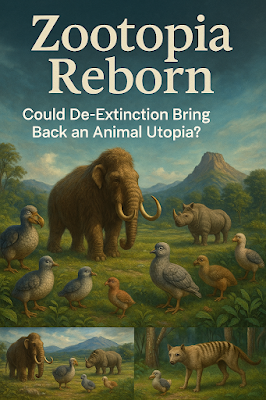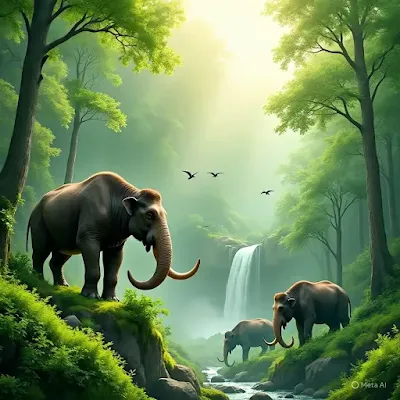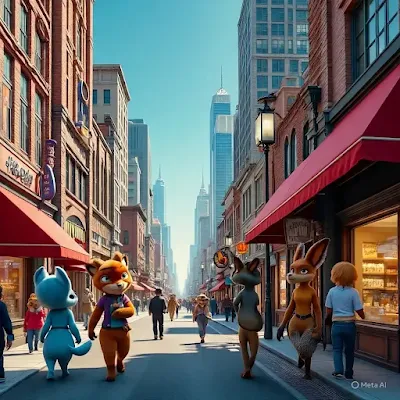Zootopia Reborn: Could De-Extinction Bring Back an Animal Utopia?
Imagine a world where woolly mammoths roam alongside rhinos, where dodos chirp in harmony with pigeons, and forests echo with the call of the thylacine once again.
Welcome to a possibility inspired by the animated fantasy of "Zootopia," now challenged by the breakthroughs in de-extinction—a real-world scientific pursuit to bring back extinct species. But could this dream of a peaceful animal utopia ever be reality? And more importantly, should it be?
Welcome to the world of new era where everything is possible!
1. What Is De-Extinction?
De-extinction refers to the process of reviving extinct species using advanced biotechnology. Scientists use preserved DNA, cloning methods, or genome editing tools like CRISPR to reintroduce lost creatures. While still in the experimental stages, some projects like the revival of the woolly mammoth or the passenger pigeon have gained major attention.
This scientific pursuit isn’t just about science fiction anymore—it's becoming science fact.
2. The Zootopia Analogy
In the movie Zootopia, predators and prey coexist in a technologically advanced city, maintaining peace despite their biological differences. It reflects a world free from human interference, discrimination, and environmental damage.
Could such a system evolve naturally if humans managed to recreate biodiversity from scratch—beginning with the rebirth of extinct animals? That’s where the idea of a real-life “Zootopia Reborn” takes flight.
3. Who’s Coming Back First?
Several species are being considered for de-extinction:
Woolly Mammoth: To combat climate change in the tundra
Passenger Pigeon: To restore balance in forest ecosystems
Thylacine (Tasmanian Tiger): To re-establish Australia’s lost predator
Dodo: A symbol of conservation comeback
These species weren’t just cute or interesting—they played important roles in their ecosystems. Their return could fix broken chains of biodiversity.
4. Challenges in Building an Animal Utopia
Despite the excitement, de-extinction is far from simple:
Ethical Concerns: Are we playing god? Would the revived animals have a real chance at survival?
Ecological Imbalance: Reintroducing an extinct species might damage current ecosystems
Habitat Loss: Even if we bring them back, where will they live?
Genetic Incompleteness: Most extinct species don’t have fully intact DNA samples
In Zootopia, infrastructure and technology were built for animals. In reality, our world is designed against them.
5. Can Revived Species Coexist Peacefully?
One major reason Zootopia worked was mutual understanding and respect among species. But real animals follow instincts, not ideals. Predators hunt prey. Territory is guarded. Dominance is established.
To build a real Zootopia, we would need to:
Train revived species in controlled environments
Prevent aggression through environment engineering
Possibly genetically modify behavior (which again raises ethical alarms)
So the question isn't just can we revive them, but can they adapt to today’s world?
6. The Role of Humans in This New World
Humans can’t be left out of this equation. In fact, our actions caused most of these extinctions. If we revive lost species, we become their caretakers—responsible for their safety, food, and habitats.
We must also confront questions like:
Will zoos become futuristic biodomes?
Will rich countries commercialize revived species?
Can local tribes be involved in managing their ancestral animals?
A true Zootopia can only exist with global cooperation, science-led ethics, and empathy for every species.
7. The Technological Leap: CRISPR and Cloning
The use of CRISPR-Cas9 technology and somatic cell cloning is revolutionizing how we think about evolution. We’re not just observing nature—we’re rewriting it.
Gene editing could allow us to:
Repair faulty DNA from ancient species
Blend extinct genes with those of living relatives
Create hybrid species fit for modern climates
But this raises the concern: if we can design life, where do we draw the line?
8. What About the Ecosystems?
Animals don’t exist in a vacuum—they interact with countless plants, prey, predators, and environmental elements. Reintroducing a single species might:
Threaten native species
Alter food chains
Spread unknown diseases
That’s why rewilding efforts must include environmental simulations and phased reintroduction plans. Nature is not a lab—it’s a web.
9. Could Extinct Animals Help Fight Climate Change?
One argument for de-extinction is climate restoration:
Mammoths could help restore the Arctic tundra by trampling snow and encouraging grass growth, slowing permafrost melt.
Large herbivores can spread seeds and maintain ecological diversity.
These animals could become allies in the war against global warming—if introduced smartly.
10. Cultural and Psychological Impact on Humans
Bringing back extinct animals won’t just affect nature—it will reshape our psyche:
Awe and wonder may reconnect us with the natural world
Ancient stories and cultural symbols could regain relevance
Children may grow up in awe of real-life dodos and mammoths
Will we still see ourselves as the apex species—or just one part of a shared biosphere?
Final Verdict: Are We Ready for Zootopia Reborn?
The tools are here. The dream is alive. But are we ready?
Zootopia Reborn isn’t just a story of reviving animals—it’s about reviving accountability, respect for nature, and rewriting our role on Earth.
It could go two ways:
🔥 A hopeful new world—where extinct species thrive, ecosystems heal, and humans coexist with their resurrected neighbors.
💀 A repeat of past mistakes—where vanity science leads to ecological collapse.
In the end, the choice isn’t about whether we can build a real Zootopia. It’s about whether we deserve to.
Written by: Roushan Gangotri |
> Subscribe for more stories that blur the line between mystery, science, and imagination.











Comments
Post a Comment